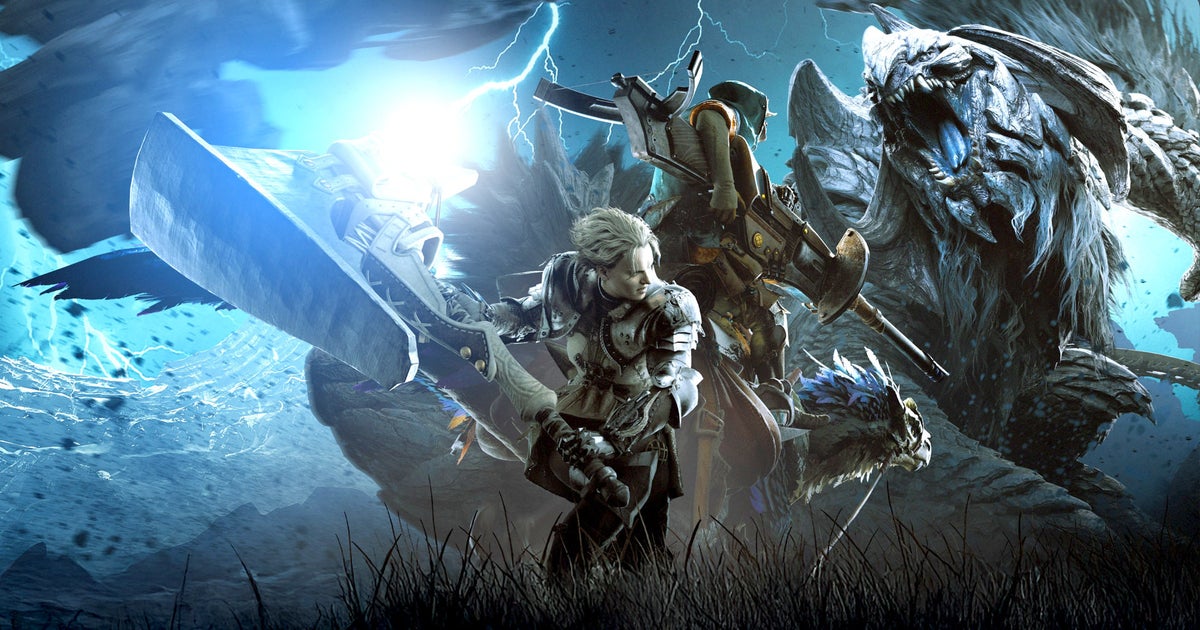Monster Hunter is back with a bang on current-gen consoles. Wilds – the latest series entry – features a seamless open world in a series first, plus plenty of visual bells and whistles courtesy of Capcom’s RE Engine. So can the longstanding series hold up to current-gen pressure? And how do performance and image quality fare across PS5, Series X, and Series S?
Let’s first focus on the areas where Monster Hunter Wilds excels. Capcom’s latest does a generally very good job of depicting wide-open gameplay spaces without too much pop in and with plenty of flora and detailed static geometry. The crags and caves of the game’s opening desert section are impressively ornate, and the game’s forested second area shows off a lush, foliage-rich environment. Wilds generally meets current-gen standards here, without hard polygonal edges or low-res texture work that might betray adherence to earlier console hardware.
The game’s titular monster hunts showcase unique foes in interesting arenas, often with fascinating secondary animation that remains interesting throughout often long fights. The same level of care also extends to NPCs, with eye-catching designs, sophisticated skin shading and hair rendering, highlighted in a surprising volume of well-animated and ambitious cutscenes. The excellent animation also extends to gameplay, with effective attack telegraphing and responsive player and mount movement.
Wilds’ lighting can also be pretty good at times. At its best, we get very effective large-scale light bounce and occlusion, which is most obvious in strong sunlight. Smaller-scale detail is mostly treated with screen-space ambient occlusion (SSAO), but archways and large rock formations seem to be lit primarily using a baked global illumination (GI) technique, which is often effective. At times, the results can be quite striking.
Wilds generally looks good and often comports itself to a reasonable current-gen visual standard then, but the visual progression is more obvious against prior series entries. 2018’s Monster Hunter World was the last to be developed on the MT Framework and has comparatively basic environments, somewhat crude-looking models and particularly less realistic character rendering. Despite its naming, World also generally features smaller environments than Wilds, and those environments are segmented into discrete playable chunks.
2021’s Monster Hunter: Rise is cruder still, despite being built on the more modern RE Engine, as it was developed around the capabilities of the Switch and features more basic environments. It’s not a bad looking game by any means, but it definitely feels like something closer to a 360 or PS3 title than World, even though I’m capturing it here on PS5.
Relative to those earlier games, I think Wilds is a clear improvement, and shows the advantages of focusing on more advanced consoles, along with a more generously resourced development on a more modern engine.
There are some areas where Wilds doesn’t necessarily match expectations though. The first thing stuck out was just how subdued the game looks in most lighting conditions, with quite compressed brightness levels – lifted blacks and suppressed highlights – and a grey look that doesn’t do the game any favours. The game looks better in brighter, more contrast-y lighting conditions, but not using the available Rec 709 luma space feels like an odd choice. Colour correcting the footage to remove this compression looks better to my eyes, and relatively minor tweaks could produce a punchier look in line with other recent triple-A titles. Beyond this, there are also weapons and armour that don’t seem to reflect light properly and have a very dark colour relative to the rest of the scene in some areas, which seems like a bug.
Beyond the grading issue, there are some obvious lighting flaws, with the game’s GI and SSAO being ineffective in shadowing carpets of foliage in jungle areas, for example. Other small-scale environments, such as tent interiors, aren’t really lit plausibly either. Wider shots of more naturalistic environments with strong direct lighting fare best, while more cramped, indirectly lit interiors can look somewhat dated. Unfortunately, the excellent ray-traced global illumination (RTGI) from Dragon’s Dogma 2 doesn’t make the cut here either, which would improve the game’s overall visual quality at the cost of performance. Perhaps as a consequence of relying on a baked lighting system, Wilds appears to have a fixed time of day too, which is a bit odd.
Beyond any lighting quirks, I think the game’s general image quality and performance metrics just aren’t great for a title like this. Wilds isn’t necessarily on the cutting edge when it comes to visual quality, but it runs like it is.


On PS5 and Xbox Series X, Wilds has three modes and two visual toggles to make for eight effective combinations. Frame-rate mode can be run with a 60fps cap, resolution mode can be run with a 30fps cap, and balanced mode can be run with a 40fps cap on 120Hz displays. All three modes can also run at 120Hz on PS5. Essentially though, you can think of these as the 60fps performance, 40fps balanced and 30fps resolution modes we’ve seen in many other current-gen console titles.
Compared side-by-side, the frame-rate mode is clearly the worst off, with a rougher and more aliased image that doesn’t hold up all that well on a 4K TV – we measured it at 900p on average. The other two mode offerings are quite close to each other in relative quality – typically 1224p for balanced and 1656p for resolution – with neither being free of aliasing, despite their higher internal resolutions.
Wilds seems to use AMD’s first-gen FSR to scale the final image to 4K, with some evidence of minor dynamic resolution scaling in play – eg frame-rate mode seems to be bound between 720p and 1080p. FSR 2 might have been a better option for PS5 to resolve a cleaner final image, and the unorthodox setup for an RE Engine game the developers have chosen doesn’t really impress.
Beyond the resolution tweaks, volumetric lighting quality, GI quality, screen-space reflections and draw distances are also adapted on each mode, with the latter two seeming to degrade only in the frame-rate mode.

In terms of PS5 and Xbox Series X performance, the frame-rate mode does land on 60fps most of the time, but there are frequent dips to lower frame-rates that are mainly smoothed out by VRR displays. Balanced mode is similar, hitting 40fps most of the time. Resolution mode gets closer to nailing a stable frame-rate at its target 30fps, but again drops below this in heavier scenes. Series X runs a hair behind PS5 most of the time, but
Enabling the frame-rate caps is at least unproblematic, with no frame pacing issues as we’ve seen in some other titles. Running without the caps in play doesn’t seem to change too much, with higher performance in some light areas, especially in frame-rate mode. Unfortunately, LFC doesn’t seem to engage properly on PS5 in balanced or resolution modes with a 120Hz output, so the game feels choppier than it should – which is a bug that ought to be solved. VRR feels better on Series X.
One pleasant surprise is that NPCs don’t suffer from the same obnoxious pop-in issues we observed in Dragon’s Dogma 2, though they do animate at reduced rates when far from the player – as do distant enemies. This was an area of concern after the issues Dragon’s Dogma suffered, but the smaller town areas in Wilds likely don’t raise the same CPU constraints.
Ultimately, Monster Hunter Wilds is a good-looking game on PS5 and Series X, but I do have concerns about its performance. Image quality and performance metrics don’t line up favourably with other current-gen software, even compared to games that are pushing out the state of the art. Performance mode in particular is of significant concern, with rough and imprecise low-resolution visuals.
The game’s outlook on Series S is simpler, with a single 30fps mode that can be unlocked and/or run at 120Hz with a supported display. Wilds unfortunately looks a lot worse here than even PS5 or Series X in frame-rate mode, with SSR being completely removed and noticeable hits to texture resolution. The game typically renders at an internal resolution at or below 1080p, for a softer resolve overall than any Series X or PS5 mode as it’s lacking the FSR and sharpening treatment used on the larger consoles. The game also runs with a 1080p UI, versus the 4K UI on Series X and PS5. Despite these significant visual cutbacks, the game still stumbles below 30fps for extended periods, and monster hunting at 25fps just doesn’t feel great. Uncapping the frame-rate does basically nothing either.


Beyond the visual minutiae, I do have to admit that Monster Hunter Wilds didn’t really grab me as a player on any system. I’ve played – and enjoyed – older Monster Hunter games before, but Wilds is a pretty overwhelming game in the sophistication of its gameplay systems. The combat involves a lot of complexity, there are so many weapon types, and the hotkey and menus systems are a little obtuse. There is so much to learn here, and the game seems to take it for granted that you have a deep affinity for the series and a lot of background knowledge before you pick up the controller. It’s an intimidating game, with gameplay detail that rivals complex MMOs like Final Fantasy 14.
Over my hours of play, I didn’t really click with the game’s combat, though there were occasional bright spots. I’m sure there will be a compelling action game here for a lot of players, but it’s submerged a bit beneath gameplay systems that aren’t exactly self-explanatory. It also doesn’t help that the game’s mode selection is relatively lacklustre and that there’s such a steep consequence for wanting to play in frame-rate mode on PS5 and Series X, where the game feels best.
The biggest issue here is that the visuals just don’t scale all that well to PS5, Series X and Series S. The lack of temporal upsampling plus the relatively constrained power of console hardware results in a less than ideal experience, at least on the tested machines. Series S in particular needs some revision, failing to reach a stable 30fps in a lot of content. We’ll have more to say about the game in follow-up content, starting with PS5 Pro, but for now I’m less than satisfied with the Wilds experience on the regular current-gen consoles.

